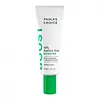What's inside
What's inside
 Key Ingredients
Key Ingredients

 Benefits
Benefits

 Concerns
Concerns

 Ingredients Side-by-side
Ingredients Side-by-side

Water
Skin ConditioningPropylene Glycol
HumectantLecithin
EmollientAlcohol
AntimicrobialPolymethyl Methacrylate
PEG-40 Hydrogenated Castor Oil
Emulsifying4-Butylresorcinol
AntioxidantAscorbyl Glucoside
AntioxidantRetinol
Skin ConditioningAzelaic Acid
BufferingNiacin
SmoothingUndecylenoyl Phenylalanine
Skin ConditioningGlycyrrhetinic Acid
Skin ConditioningMorus Alba Root Extract
BleachingDiacetyl Boldine
Skin ConditioningPEG/PPG-20/6 Dimethicone
EmulsifyingSodium Cholate
Skin ConditioningPolysorbate 20
EmulsifyingXanthan Gum
EmulsifyingCarbomer
Emulsion StabilisingTriethanolamine
BufferingTocopheryl Acetate
AntioxidantBHT
AntioxidantSodium Hydroxide
BufferingCaprylic/Capric Triglyceride
MaskingSodium Chloride
MaskingHydroxypropyl Cyclodextrin
MaskingBHA
AntioxidantPentaerythrityl Tetra-Di-T-Butyl Hydroxyhydrocinnamate
AntioxidantTriisopropanolamine
BufferingHydrochloric Acid
BufferingPhenoxyethanol
PreservativeEthylhexylglycerin
Skin ConditioningParfum
MaskingCitronellyl Methylcrotonate
MaskingCitral
PerfumingCoumarin
PerfumingEugenol
PerfumingLimonene
PerfumingIsoeugenol
PerfumingWater, Propylene Glycol, Lecithin, Alcohol, Polymethyl Methacrylate, PEG-40 Hydrogenated Castor Oil, 4-Butylresorcinol, Ascorbyl Glucoside, Retinol, Azelaic Acid, Niacin, Undecylenoyl Phenylalanine, Glycyrrhetinic Acid, Morus Alba Root Extract, Diacetyl Boldine, PEG/PPG-20/6 Dimethicone, Sodium Cholate, Polysorbate 20, Xanthan Gum, Carbomer, Triethanolamine, Tocopheryl Acetate, BHT, Sodium Hydroxide, Caprylic/Capric Triglyceride, Sodium Chloride, Hydroxypropyl Cyclodextrin, BHA, Pentaerythrityl Tetra-Di-T-Butyl Hydroxyhydrocinnamate, Triisopropanolamine, Hydrochloric Acid, Phenoxyethanol, Ethylhexylglycerin, Parfum, Citronellyl Methylcrotonate, Citral, Coumarin, Eugenol, Limonene, Isoeugenol
Water
Skin ConditioningAzelaic Acid
BufferingC12-15 Alkyl Benzoate
AntimicrobialCaprylic/Capric Triglyceride
MaskingMethyl Glucose Sesquistearate
EmollientGlycerin
HumectantCetearyl Alcohol
EmollientGlyceryl Stearate
EmollientDimethicone
EmollientSalicylic Acid
MaskingAdenosine
Skin ConditioningGlycyrrhiza Glabra Root Extract
BleachingBoerhavia Diffusa Root Extract
Skin ProtectingAllantoin
Skin ConditioningBisabolol
MaskingCyclopentasiloxane
EmollientXanthan Gum
EmulsifyingSclerotium Gum
Emulsion StabilisingPropanediol
SolventButylene Glycol
HumectantPhenoxyethanol
PreservativeWater, Azelaic Acid, C12-15 Alkyl Benzoate, Caprylic/Capric Triglyceride, Methyl Glucose Sesquistearate, Glycerin, Cetearyl Alcohol, Glyceryl Stearate, Dimethicone, Salicylic Acid, Adenosine, Glycyrrhiza Glabra Root Extract, Boerhavia Diffusa Root Extract, Allantoin, Bisabolol, Cyclopentasiloxane, Xanthan Gum, Sclerotium Gum, Propanediol, Butylene Glycol, Phenoxyethanol
 Reviews
Reviews

Ingredients Explained
These ingredients are found in both products.
Ingredients higher up in an ingredient list are typically present in a larger amount.
Azelaic acid is a multitasker ingredient that helps treat acne, pigmentation, and irritation. It is a great option for sensitive skin.
What makes azelaic special?
The best thing about azelaic acid is it's gentleness. It's generally well-tolerated and safe to use alongside other actives like niacinamide or salicylic acid.
Unlike AHAs, azelaic acid will not make you photosensitive/sun sensitive.
You can find this ingredient naturally occurring in grains like wheat, rye, and barley. In cosmetics, azelaic acid is typically lab-made, which is more stable and effective.
Learn more about Azelaic AcidThis ingredient is an emollient, solvent, and texture enhancer. It is considered a skin-softener by helping the skin prevent moisture loss.
It helps thicken a product's formula and makes it easier to spread by dissolving clumping compounds.
Caprylic Triglyceride is made by combining glycerin with coconut oil, forming a clear liquid.
While there is an assumption Caprylic Triglyceride can clog pores due to it being derived from coconut oil, there is no research supporting this.
Learn more about Caprylic/Capric TriglyceridePhenoxyethanol is a preservative that has germicide, antimicrobial, and aromatic properties. Studies show that phenoxyethanol can prevent microbial growth. By itself, it has a scent that is similar to that of a rose.
It's often used in formulations along with Caprylyl Glycol to preserve the shelf life of products.
Water. It's the most common cosmetic ingredient of all. You'll usually see it at the top of ingredient lists, meaning that it makes up the largest part of the product.
So why is it so popular? Water most often acts as a solvent - this means that it helps dissolve other ingredients into the formulation.
You'll also recognize water as that liquid we all need to stay alive. If you see this, drink a glass of water. Stay hydrated!
Learn more about WaterXanthan gum is used as a stabilizer and thickener within cosmetic products. It helps give products a sticky, thick feeling - preventing them from being too runny.
On the technical side of things, xanthan gum is a polysaccharide - a combination consisting of multiple sugar molecules bonded together.
Xanthan gum is a pretty common and great ingredient. It is a natural, non-toxic, non-irritating ingredient that is also commonly used in food products.
Learn more about Xanthan Gum